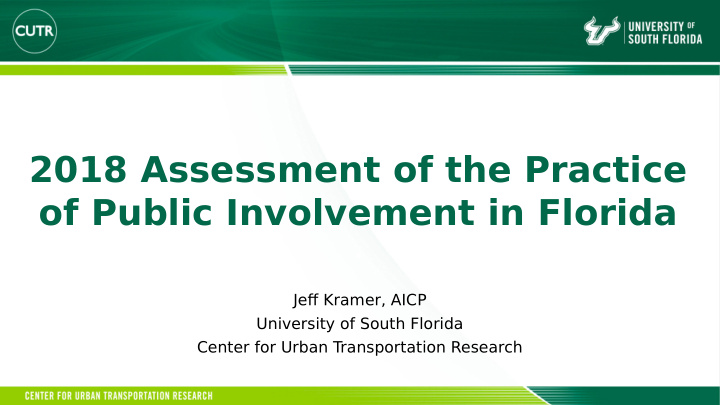



2018 Assessment of the Practice of Public Involvement in Florida . Jefg Kramer, AICP University of South Florida Center for Urban Transportation Research
Project Objectives Document current PI practices for FDOT and MPOs Compare current fjndings with 2006 study Identify additional training needs and/or improvements Develop suggestions for improved PI
Methodology Survey of all 27 MPOs in the Florida • Up to forty-two questions, based on survey logic Survey topics related to public involvement • Budget • Performance measures • Communication methods • Training • Perceptions of efgectiveness • Challenges
General Findings Diverse techniques are used to engage the public Roles and responsibilities have become clearer Evident commitment to reaching underserved populations and new audiences Performance measures exist, but mostly at the “output” level Interagency communication has improved Social media is emerging as a method to engage the public Stafg received varying levels of public involvement training Several key challenges are faced when involving the public
Key Challenges Reaching all afgected groups Reduced capacity due to constrained resources Difgering goals among planning agencies Capturing the interest of the members of the public Involving the public too late
Budget Allocation 10 9 9 8 7 7 7 6 5 Number of MPOs 4 4 3 2 1 0 <10% 10-24% 25-49% >50% 0 Not sure Percent of total budget allocated for public involvmeent
Training Received 25 21 20 Number of MPOs 15 10 4 5 2 0 Yes No Not sure T raining received by stafg
Diverse Techniques for Public Engagement Public Involvement T echniques Used 26 24 23 21 20 Public involvement rechnique 19 18 17 16 15 14 11 7 3 0 5 10 15 20 25 30 Number of MPOs
Most Efgective Techniques for Public Engagement Social media 1 Public meetings Open houses Newspaper advertisements Newsletters Interactive GIS applications Facilitated meetings Public involvement technique Other 2 Radio/TV advertisements Individual/small group briefjngs Advisory committees Surveys 3 Community fairs 4 0 1 2 3 4 Number of MPOs
Least Efgective Techniques for Public Engagement T elephone hotline 1 Open houses Dedicated web page Facilitated meetings 2 Public involvement technique Newsletters 3 Community fairs 4 Newspaper advertisements 7 Public meetings 8 0 1 2 3 4 5 6 7 8 Number of MPOs
Social Media Platforms 25 21 20 15 Number of MPOs 15 13 10 5 4 4 0 Facebook T witter YouTube Instagram LinkedIn Social media platforms
Performance Measures Performance Measures T ype of Performance Measures 30 14 13 26 12 25 10 10 20 8 Number of MPOs Number of MPOs 15 6 4 10 3 2 1 5 1 0 0 Type of performance measures Performance measures used Output-based Outcome-based Yes No Both No answer
Suggestions 1. Provide a mix of general and project-specifjc resources where possible 2. Social media guidelines should be reconsidered in light of how they might be made more fmexible and efgective for use as a public involvement tool 3. Comprehensive evaluation techniques for public involvement, particularly outcome-based performance measures, should be more widely implemented 4. More frequent and more comprehensive training should be considered, including higher level training focusing on specifjc aspects of public involvement practice 5. Networks of shared responsibility and opportunities for partnership should be leveraged to extend agencies’ reach, strengthen relationships with shareholders, and increase the value of public involvement spending through more efgective feedback
Kramer@cutr.usf.edu
Recommend
More recommend